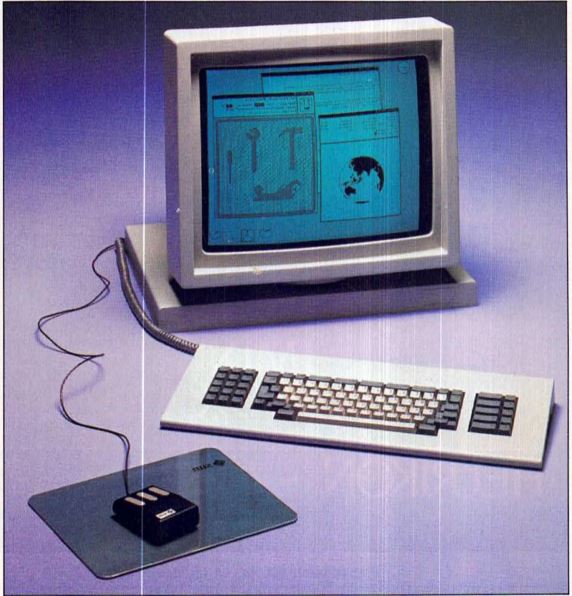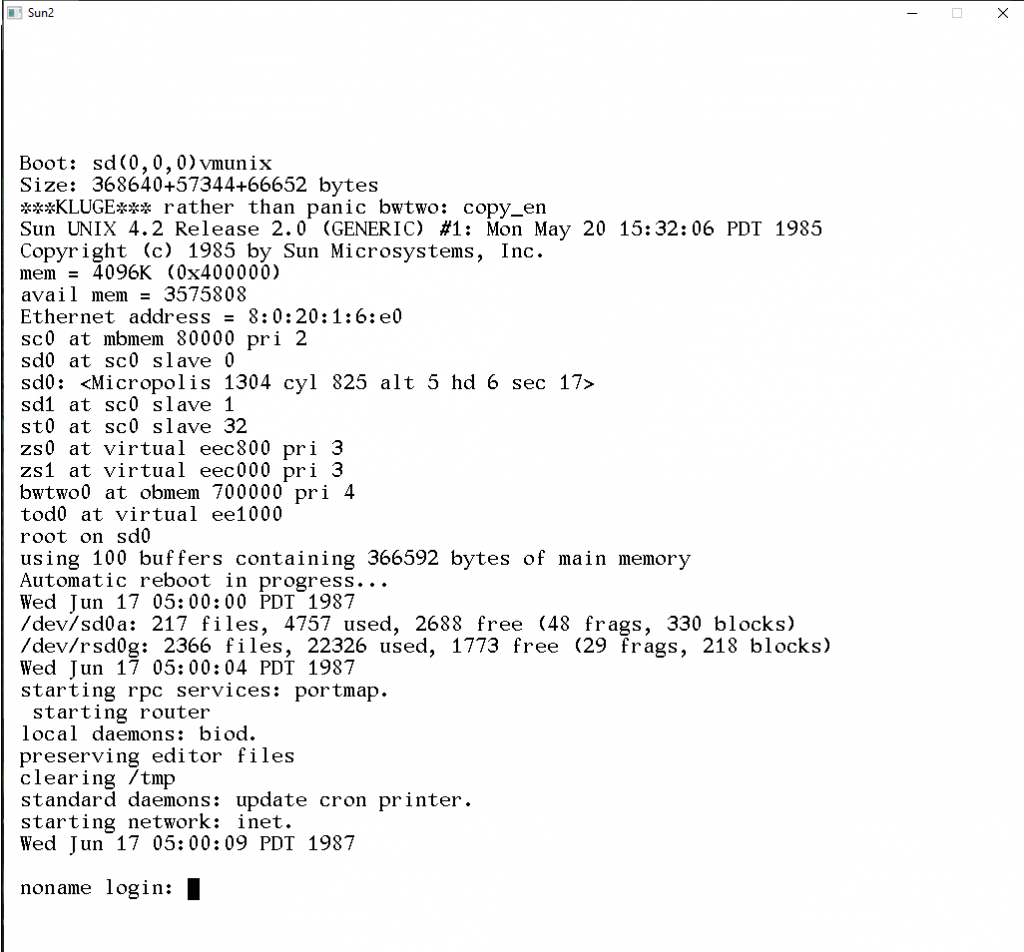
Since I was playing with the 68000 based GCC ’87 I know it was going to be more geared to SUN workstations, certainly of the early 80’s vintage as they would be the most ‘affordable/cheap/donated’ to FSF (Or so I’d imagine).
Naturally the go to emulator is TME, however this time while searching around for the install scripts and stuff I found lisper‘s (heeltoe.com) emulator-sun-2, a greatly cut down and SUN-2 focused emulator that emphasizes ease of use.
Wait, what? SUN-2, and ease of use? Why yes, not only that, as it uses SDL 1.2 it also means it’s much easier to compile. After an hour of messing around with it, I had it running on Windows. After a few minutes I had it running on my ARM based Acer NovaGO.

At it’s core is the m68k 68010 emulation from Karl Stenerud‘s Musashi core which is a great choice for the SUN-2 as it’s a 68010 based machine. Some fun notes from web.cuzuco.com/~cuzuco/sun2/ include:
- CPU is a Motorola 68010 running at 10MHz
- Maximum physical memory is 4 Megabytes
- Maximum virtual memory is 16 Megabytes
- All I/O is via a Multibus (an Intel design)
- Main disk is a SMD, the largest size is 380Mbyte
- Has a SCSI adapter, but the disk is slow and small (42Mbyte)
- Sun was just finishing NFS
- alludes to future AT&T UNIX System VI and VII
- Display supported dual heads and a resolution of 1152×900
- List price as tested: $44,900
- Sun was still private, had 400 employees and sold 1500 units
You can read about the debut of the SUN-2 in the UNIX/WORLD Magazine, VOlume 1, Number 5 dated October 1984 in archive.org. It starts on page 86.
I started to integrate sigurbjornl’s patches for networking but I think I need to work through SunOS 2.0’s weird VAX 4.2BSD arp issues (anyone have the source code to SunOS 2.0?!). I’ll probably update it with UDP or some fixed ARP thing to remove that or just let the SUN-2 talk to a VAX with 4.2BSD so they can be weird, together.
I’m also pretty sure my old Cockatrice III sort of debugged SLiRP thing broke the packed structs to let it work properly when compiled with Microsoft C, so I’ll have to break down and either try to fix that, or update and borrow the vastly updated SLiRP from SIMH.
For Windows users who want to play along the bundle is on the terribly named page “Ancient UNIX/BSD emulation on Windows” as SUN2.zip.

$44000!
$44,000 in 1987 is equivalent in purchasing power to about $99,532.18 in 2020.
Crazy how expensive UNIX machines were! And SUN pioneered “affordable” workstations.
I should find out how much a MicroVAX cost, I suspect it’s much more?
To me the killer is that it’s a 68000 based. No wonder the old binary in the gnu archive is for the super cheap Atari ST.
It’s no wonder the flood of Taiwanese 386 clones fundamentally changed the world, just as v86 mode was the greatest thing Intel cloned from the 370.
It is foolish to use inflation calculators on computer prices.
1) Documentation for inflation calculators states that they work best, possible work at all, with low cost items.
2) Computer prices are set to target a particular range consumers.
3) Computer prices are based on the price of comparable equipment.
When you see $44000 the first thing you should look for is what the competition was selling for.
Go look at the 1990 prices of high-end PeeCees and compare them to high end today and they are not far apart.
No one is going to spend $99,532.18 on a Sun 2 so that amount is just a faerie tale.
professionally I’ve spent hundreds of thousands on single machines in the mid 90’s. An array of over 300 4GB scsi2 disks is not cheap by any stretch of the imagination, nor is high end systems.
Compaq quad pentium pro servers with hundreds of megabytes to gigabytes of ram back in the 90’s were substantially more expensive than their desktop peers, despite having the same CPU’s and OSs.
Cool. I remember working with entire cabinets of full-height SCSI drives in a RAID (or was that JBOD?) One of the cabinets had about 20 GB and the other 40 GB.
> When you see $44000 the first thing you should look for is what the competition was selling for.
I think the competition was DEC VAX-11. Admittedly a Sun-2 was slower than a VAX-11.
On USENET in net.unix-wizards
From: Russel Sandberg
Date: Jul 21, 1983
Subject: Re: mixing 256k & 1M memory boards – (nf)
We just got our sun up running Berkeley 4.1c with a
Fujitsu 80 Mbyte disk. Here are the benchmark results:
cc hello.c on SUN
10r 1.1u 2.2s 32%
We also ran the benchmark on some of our vaxes. Here are those
numbers:
VAX/780 rp07 disk, dual memory controllers, 4.1bsd
4r 0.4u 1.4s 45%
VAX/750 Fujitsu 160, SI 9900 controller, 4.1bsd
6r 1.0u 1.8s 46%
VAX/750 Eagle, SI 9900 controller, 4.1c
6r 1.0u 2.4s 57%
VAX/730 Fujitsu 160, SI 6600, 4.1c
12r 2.2u 6.2s 66%
Below is another benchmark that we run on virtual memory systems.
We tried it out on the National 16032 system at USENIX and it
crashed! Here are some numbers from our machines: (only real
time is given)
780 (4.1bsd): 0:20
750 (4.1bsd): 0:28
750 (4.1c): 0:30
730 (4.1c): 1:02
SUN (4.1c): 8:56 (slow!)
Masscomp: 12:56 note: ran out of memory at 70 (not virtual memory)
If people would run this test (time vmbench) on their own systems
and mail me the results I will post them to the net.
*****************************************************************
vmbench.c
*****************************************************************
#include
main()
{
int i, pid;
char *a, *malloc();
pid = getpid();
if (fork()) {
/* parent waits for last child signal (for time) */
pause();
}
for (i=0; i<100; i++) {
a = malloc(10000);
if (i%10 == 0) printf("%d: a=%x\n", i, a);
if (fork()) exit(0);
}
kill(pid, SIGINT);
}
How do you get to the GUI ?
I tried “b st()” but no cigar…
“b” boots to some CLI but what next ?
Tried with all the tapes from winworldpc…
TIA
Oh, I think the image is cli only. I need to do an install… I think it’s ‘startx’ once X11 is installed. Although truth told I’ve only barley used SunOS.
Oh OK, no problem.
Thanks
I found a video with an actual SUN-2, and the command is actually ‘suntools’.
I really will have to do a re-install from the 2.0 tape sources I found online as it’s not on the disk image.
sun2 and early sun3 isn’t X10 or X11 era at all.
I saw in the early 90s the move from sun3 to sun4 and saw a bit of the difference – X11 (X10 ?) is slugish on a sun 3/60 (which is far faster than a sun2)
Here are some sources, SunOS 2.0 is apparently in there as well:
https://archive.org/download/sunsolaris/sources/
Those were uploaded by Tenox, not me…
From these instructions :
https://www.sun3arc.org/install/install.phtml
All the “tapes” are there :
https://winworldpc.com/product/sunos/2x
So I put the tape files in the right place, the emulator acknowleges them, but “b st()” does not work…
Any hint ?
the emulator doesn’t read tap files. Instead it’s a directory with the files 01 02 03 etc…
it is in “01 02 03 etc” files in the archives…
Tenox has now uploaded them here: http://tenox.pdp-11.ru/sunos_solaris/sparc/sources/
crazy ports of “OpenSolaris” https://bitbucket.org/hayashin/illumos-gate/wiki/Home
whoa. Solaris on the DecAlpha! If only it were 1997!
Why am I only finding out about this now? This is awesome.
Yeah I was pretty surprised myself! I would have expected to have heard about this on TUHS or any of the other old geezer Unix things out there.
Compared to TME it’s straight forward. Lol
“Why yes, not only that, as it uses SDL 1.2 it also means it’s much easier to compile.”
Oh good! I’ve found, for me at least, TME to be completely impossible to compile. I have plenty of SPARC systems, but I’ve yet to find any m68k Sun systems.
SUN2.zip which is linked in the OP was moved to:
https://sourceforge.net/projects/bsd42/files/4BSD%20under%20Windows/v0.4/sun2.zip/download
This GitHub repo can also be used:
https://github.com/lisper/emulator-sun-2.git